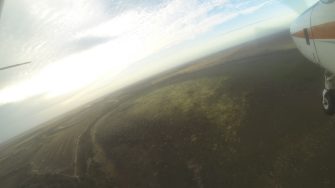
Date: Wednesday, November 7, 2018
Project: Eastern Australian Waterbird Survey
Observer: Richard Kingsford
We headed off early again to do the final set of wetlands on this leg – the Kerang Lakes. We started with a series of shallow salt lakes, including Lake Tutchewop. Lovely pink hues on the water surface but not much in the way of waterbirds, just a few teal and silver gulls.
Spectacular colours of the salt lake, Lake Tutchewop
Then there were the lakes which are kept constantly full, including Kangaroola Lake, Racecourse Lake and Lake Charm. These were by far the largest and most extensive areas of water in the whole system but barely had a handful of waterbirds on each. They are typically the same few waterbirds, pelicans, cormorants, the odd coot and darters. With the water kept artificially high, these lakes don’t get a chance to dry out and so lose their productivity.
Surveying Kangaroola Lake
Surveying Lake Charm
The other group of lakes out here are the salt lakes, some of which are harvested for salt and gypsum. These lakes have a very shallow film of water and no waterbirds.
Harvesting salt and gypsum on Salt Lake
There was one spectacular waterbird lake today – Lake Cullen. I am assuming this lake is not regulated because the water was not at highlevel – shallow water and lots of food. It was fantastic with tens of thousands of waterbirds, mainly teal, black swans, coot, some pink-eared duck, pied stilts, whiskered terns and some hardhead. There were a range of other species as well. This was such a contrast to the permanently full lakes. No doubt if you went down on the water and sampled for aquatic vegetation and invertebrates, you would find the lake was absolutely brimming with microscopic life which would be a huge contrast to the full lakes a stone’s throw away.
Lake Cullen with hundreds of swans all around its edge.
Surveying thousands of waterbirds on Lake Cullen
The most western lakes which also dry and flood, when there is enough water, were all dry.
Dry Lake Bael Bael
We finished up our survey on the three most western lakes of the Kerang Lakes system. These also have their water levels kept high and also probably don’t have great productivity for waterbirds. There were similarly relatively few waterbirds and primarily fish eating ones, the cormorants, pelicans and darters. Middle Lake is the most different with large reed bed areas, while Reedy Lake the most southerly one, also has reed beds although not quite as extensive as in Middle Lake. Middle Lake has had large colonies of thousands of pairs of breeding ibis in the past, but not today. Reedy Lake had a couple of small breeding colonies of straw-necked and white ibis of about fifty in each. We finished this leg of the survey at about 8.30 and then headed for Griffith to refuel before heading back to Sydney.
Third Lake
Middle Lake
Surveying waterbirds on Middle Lake.
Small colonies of ibis breeding on Reedy Lake.
